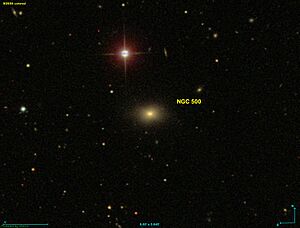NGC 500 facts for kids
NGC 500 is a fascinating galaxy located far, far away in space. It's a special type of galaxy called a lenticular galaxy. Imagine a mix between a spiral galaxy, like our own Milky Way, and an oval-shaped galaxy. NGC 500 is found in the constellation known as Pisces. This galaxy is incredibly distant from us, about 553 million light-years away.
Contents
What is NGC 500?
NGC 500 is a galaxy, which is a huge collection of stars, gas, dust, and dark matter, all held together by gravity. Our own solar system, including Earth, is part of a galaxy called the Milky Way. NGC 500 is much further away than anything we can see with our eyes alone.
What is a Lenticular Galaxy?
A lenticular galaxy is a type of galaxy that looks like a lens or a disc without clear spiral arms. It has a bright central bulge, similar to a spiral galaxy. However, it lacks the distinct, winding arms that you see in galaxies like the Milky Way. Scientists believe lenticular galaxies might be old spiral galaxies that have used up most of their gas and dust. This means they don't form many new stars anymore.
How Far Away is NGC 500?
NGC 500 is about 553 million light-years away from our Milky Way galaxy. A light-year is the distance light travels in one year. Light moves incredibly fast, but space is so vast that it still takes light millions of years to cross these distances. This means when we look at NGC 500 through a telescope, we are seeing it as it was 553 million years ago!
Where Can We Find NGC 500?
You can find NGC 500 in the constellation of Pisces. A constellation is a group of stars that form a recognizable pattern in the night sky. People have given these patterns names, often based on animals, mythical figures, or objects. Pisces is known as "The Fish." While you can see the stars of Pisces, you would need a powerful telescope to spot NGC 500 itself.
Who Discovered NGC 500?
NGC 500 was first observed by astronomers in the 19th century. It was discovered by Bindon Blood Stoney and William Parsons, 3rd Earl of Rosse. These early astronomers used telescopes to map the night sky and find new celestial objects. Their work helped us understand more about the universe beyond our own galaxy.
See also
 In Spanish: NGC 500 para niños
In Spanish: NGC 500 para niños


